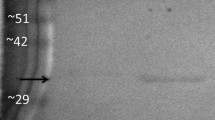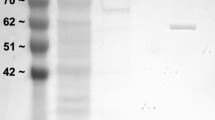Summary
The susceptibility to inactivation by hydrostatic pressure of the tetrameric (Fig. 1) muscletype (M4) lactate dehydrogenase homologues (LDH, EC 1.1.1.27;l-lactate: NAD+ oxidoreductase) from six confamilial macrourid fishes was compared at 4 °C. These marine teleost fishes occur over depths of 260 to 4815 m. The pressures necessary to half-inactivate the LDH homologues are related to the pressures which the enzymes are exposed to in vivo (Table 1); higher hydrostatic pressures are required to inactivate the LDH homologues of the deeper-occurring macrourids. The resistance of the LDH homologues to inactivation by pressure is affected by protein concentration (Fig. 3). After an hour of incubation at pressure, the percent remaining activity approaches an asymptotic value (Fig. 2). The inactivation of the macrourid LDH homologues by pressure was not fully reversible. Assuming that inactivation by pressure was due to dissociation of the native tetramer to monomers, apparent equilibrium constants (K eq) were calculated. Volume changes (ΔV) were calculated over the range of pressures for which plots inK eq versus pressure were linear (Fig. 4). The ΔV of dissociation values of the macrourid homologues range from −219 to −439 ml mol−1 (Table 1). Although the hydrostatic pressures required to inactivate the LDH homologues of the macrourid fishes are greater than those which the enzymes are exposed to in vivo, the pressure-stability of these enzymes may reflect the resistance of these enzymes to pressure-enhanced proteolysis in vivo.
Similar content being viewed by others
References
Alexandrov VYa (1977) Cells, molecules and temperature. Springer, Berlin Heidelberg New York
Bradford MM (1976) A rapid and sensitive method for the quantitation of microgram quantities of protein utilizing the principle of protein-dye binding. Analyt Biochem 72:248–254
Brewer GJ (1970) An introduction to isozyme techniques. Academic Press, New York
Childress JJ, Somero GN (1979) Depth-related enzymic activities in muscle, brain and heart of deep-living pelagic marine teleosts. Mar Biol 52:273–283
Everse J, Kaplan NO (1973) Lactate dehydrogenase: Structure and function. Adv Enzymol 37:61–133
Goldberg AL, Dice JF (1974) Intracellular protein degradation in mammalian and bacterial cells. Annu Rev Biochem 43:835–869
Heremans K (1982) High pressure effects on proteins and other biomolecules. Annu Rev Biophys Bioeng 11:1–21
Hochachka PW, Somero GN (1984) Biochemical adaptation. Princeton University Press, Princeton New Jersey
Jaenicke R (1981) Enzymes under extremes of physical conditions. Annu Rev Biophys Bioeng 10:1–67
Jaenicke R (1983) Biophysical processes under high hydrostatic pressure. Naturwissenschaften 70:332–341
Jaenicke R, Rudolph R (1983) What NAD-dependent dehydrogenases teach us about the folding and association of oligomeric proteins. In: Sund H, Ulrich V (eds) Biological oxidations. Springer, Berlin Heidelberg New York, pp 62–90
Johnson FH, Eyring H, Stover BJ (1974) The theory of rate processes in biology and medicine. Wiley, New York
Kauzmann W, Bodanszky A, Rasper J (1962) Volume changes in protein reactions. II. Comparison of ionization reactions in proteins and small molecules. J Am Chem Soc 84:1777–1788
Kiltz HH, Keil W, Griesbach M, Petry K, Meyer H (1977) The primary structure of porcine lactate dehydrogenase: Isozymes M4 and H4. Hoppe-Seylers Z Physiol Chem 358:123–127
Laemmli UK (1970) Cleavage of structural proteins during assembly of the head of bacteriophage T4. Nature 227:680–685
Marquis RE, Fenn MO (1969) Dilatometric study of streptococcal growth and metabolism. Can J Microbiol 15:933–940
Morild E (1981) The theory of pressure effects on enzymes. Adv Protein Chem 34:93–166
Müller K, Lüdemann HD, Jaenicke R (1981) Reconstitution of lactic dehydrogenase from pig heart after reversible high-pressure dissociation. Biochemistry 20:5411–5416
Müller K, Lüdemann HD, Jaenicke R (1982) Thermodynamics and mechanism of high-pressure deactivation and dissociation of porcine lactic dehydrogenase. Biophys Chem 16:1–7
Penniston JT (1971) High hydrostatic pressure and enzymic activity: Inhibition of multimeric enzymes by dissociation. Arch Biochem Biophys 142:322–332
Peterson GL (1983) Determination of total protein. Methods Enzymol 91:95–119
Poulik MD (1957) Starch gel electrophoresis in a discontinuous system of buffers. Nature 198:1477–1479
Schade BC, Rudolph R, Lüdemann HD, Jaenicke R (1980) Reversible high-pressure dissociation of lactic dehydrogenase from pig muscle. Biochemistry 19:1121–1126
Schmid G, Lüdemann HD, Jaenicke R (1978) Oxidation of sulfhydryl groups in lactate dehydrogenase under high hydrostatic pressure. Eur J Biochem 86:219–224
Schmid G, Lüdemann HD, Jaenicke R (1979) Dissociation and aggregation of lactic dehydrogenase by high hydrostatic pressure. Eur J Biochem 97:407–413
Siebenaller JF (1978) Genetic variability in deep-sea fishes of the genusSebastolobus (Scorpaenidae). In: Battaglia B, Beardmore J (ed) Marine organisms: genetics, ecology and evolution. Plenum Press, New York, pp 95–122
Siebenaller JF (1984a) Pressure-adaptive differences in NAD-dependent dehydrogenases of congeneric marine fishes living at different depths. J Comp Physiol B 154:443–448
Siebenaller JF (1984b) Analysis of the biochemical consequences of ontogenetic vertical migration in a deep-living teleost fish. Physiol Zool 57:598–608
Siebenaller JF, Somero GN (1982) The maintenance of different enzyme activity levels in congeneric fishes living at different depths. Physiol Zool 55:171–179
Siebenaller JF, Somero GN, Haedrich RL (1982) Biochemical characteristics of macrourid fishes differing in their depths of distribution. Biol Bull 163:240–249
Somero GN, Siebenaller JF, Hochachka PW (1983) Biochemical and physiological adaptations of deep-sea animals. In: Rowe GT (ed) The sea, vol 8. Wiley, New York, pp 261–330
Spielman H, Erickson RP, Epstein CJ (1973) The separation of lactate dehydrogenase X from other lactate dehydrogenase isozymes of mouse testes by affinity chromatography. FEBS Lett 35:19–23
Sullivan KM, Somero GN (1980) Enzyme activities of fish skeletal muscle and brain as influenced by depth of occurrence and habits of feeding and locomotion. Mar Biol 60:91–99
Weber G, Drickamer HG (1983) The effect of high pressure upon proteins and other biomolecules. Q Rev Biophys 16:89–112
Wheatley DN (1984) Intracellular protein degradation: basis of a self-regulating mechanism for the proteolysis of endogenous proteins. J Theor Biol 107:127–149
Wilson RR Jr, Waples RS (1983) Distribution, morphology and biochemical genetics ofCoryphaenoides armatus andC. yaquinae (Pisces: Macrouridae) in the central and eastern North Pacific. Deep-Sea Res 30:1127–1145
Wilson RR Jr, Waples RS (1984) Electrophoretic and biometric variability in the abyssal grenadierCoryphaenoides armatus of the western North Atlantic, eastern South Pacific and eastern North Pacific Oceans. Mar Biol 80:227–237
Yancey PH, Somero GN (1978) Temperature dependence of intracellular pH: Its role in the conservation of pyruvate apparentK m values of vertebrate lactate dehydrogenase. J Comp Physiol 125:129–134
Zobell CE, Oppenheimer CH (1950) Some effects of hydrostatic pressure on the multiplication and morphology of marine bacteria. J Bacteriol 60:771–778
Author information
Authors and Affiliations
Rights and permissions
About this article
Cite this article
Hennessey, J.P., Siebenaller, J.F. Pressure inactivation of tetrameric lactate dehydrogenase homologues of confamilial deep-living fishes. J Comp Physiol B 155, 647–652 (1985). https://doi.org/10.1007/BF00694577
Accepted:
Issue Date:
DOI: https://doi.org/10.1007/BF00694577




